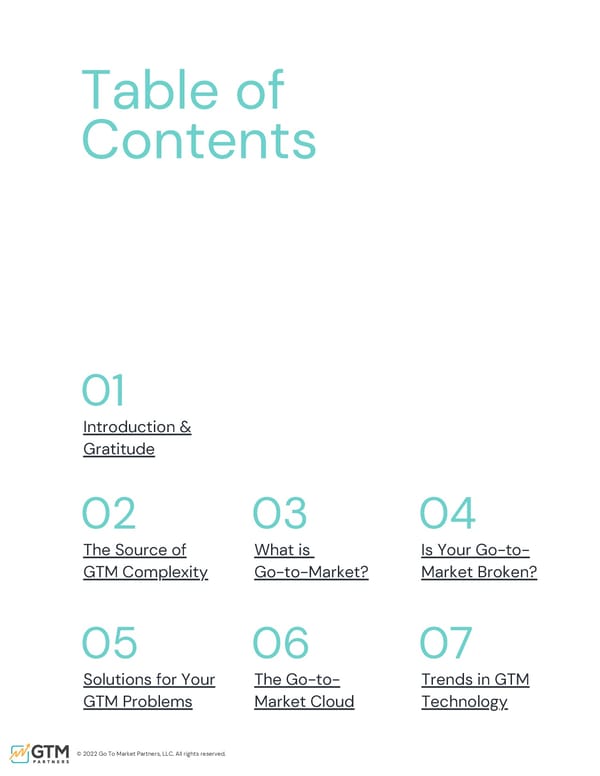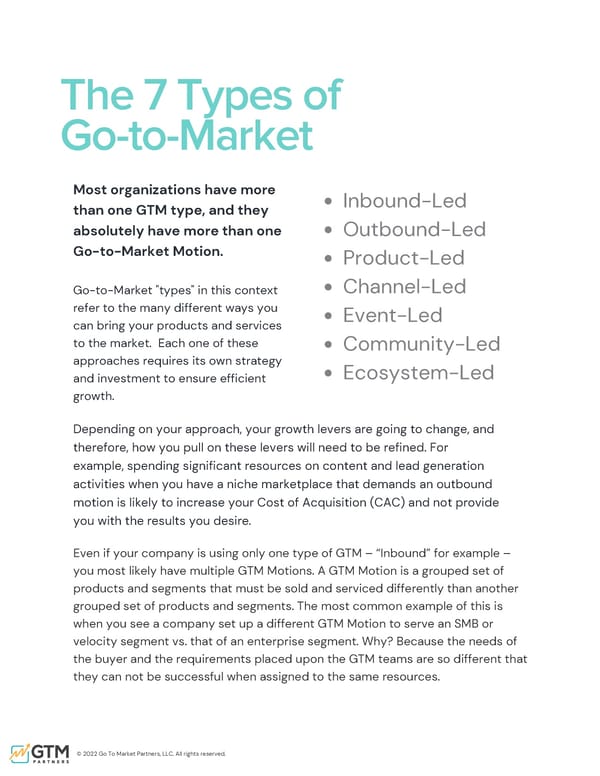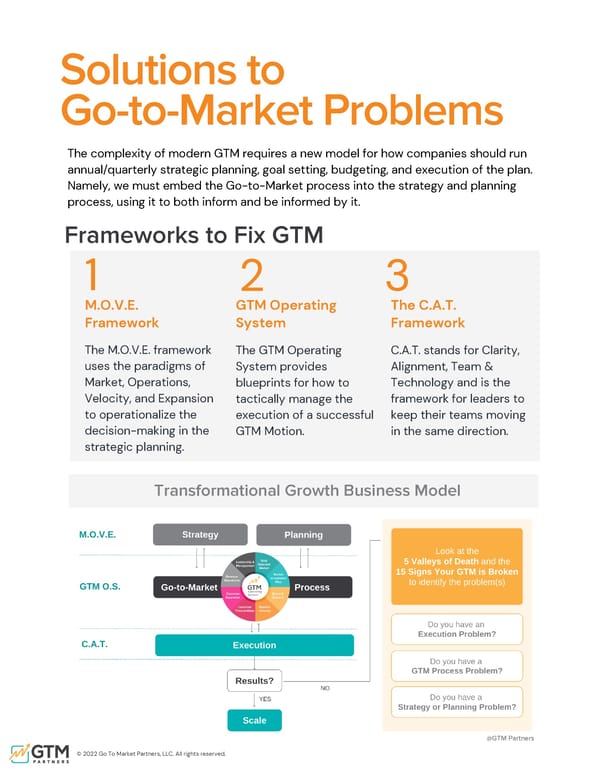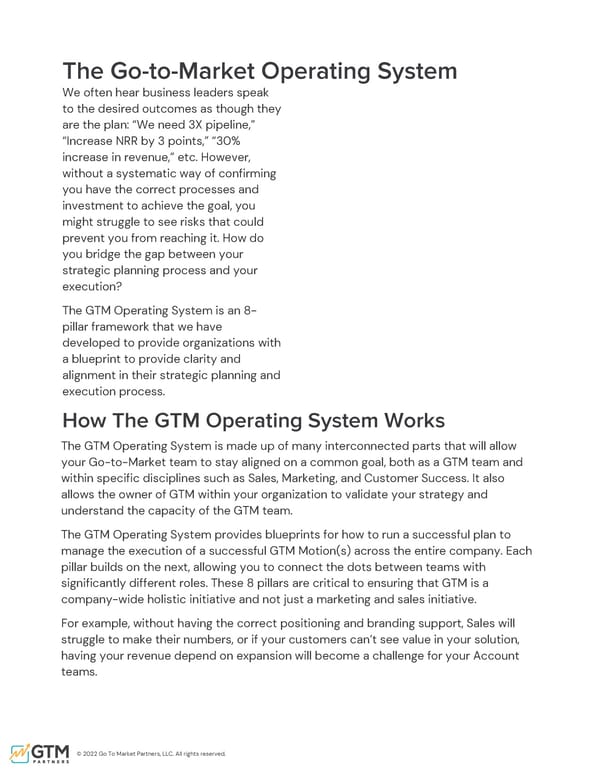The Comprehensive Guide to GTM
Comprehensive Guide
GTM Partners
Guide
Report
These materials have been prepared by GTM Partners for the exclusive and individual use of our clients. Unauthorized reproduction is strictly prohibited. These materials contain valuable, confidential, and proprietary information belonging to GTM Partners and may not be shared with any third party without the prior approval of GTM Partners. To learn how you can become a GTM Partners client, visit www.gtmpartners.com.

Table of Contents 01 Introduction & Gratitude 02 03 04 The Source of What is Is Your Go-to- GTM Complexity Go-to-Market? Market Broken? 05 06 07 Solutions for Your The Go-to- Trends in GTM GTM Problems Market Cloud Technology © 2022 Go To Market Partners, LLC. All rights reserved.
Introduction When the founders of GTM Partners started working with hundreds of companies on the concept of Go-to-Market(GTM), they came to the conclusion that there is a massive challenge facing B2B business leaders today. Though the issue can manifest in dozens of ways, it always boils down to a single concept: Go-To-Market is broken. We know that to make a bold statement like that, we need data, research, and market validation to back it up. Through our Data Partnerships with G2 and Bombora, the development of the best-selling book "Move: The 4-question Go-to-Market Framework," and through the support of our founding members and vendors, we have validated that B2B leaders have a big problem to solve, and we believe that they shouldn't have to solve it alone. When there is a universal shift in the way businesses should operate, it creates challenges and opportunities. It is our hope that those business leaders looking for a better way to drive more efficient growth in their organizations will find this guide to be the beginning of their journey to help us transform Go-to-Market. We also hope that vendors looking to improve Go-to-Market for their customers will appreciate our view that stack ranking vendors against one another without a use-case-driven solution framework makes about as much sense as arguing over the best flavor of ice cream. In our inaugural report "The Comprehensive Guide to Go-to-Market," we will outline the source of the challenges in Go-to-Market today, describe frameworks on how to resolve them, and provide you with an impartial look at the GTM technology landscape filled with solutions that can change the way you work for the better. Finally (despite its length), this guide is just the tip of a very large iceberg that we are determined to help business leaders navigate. So suffice it to say, we are just getting started, and we hope to have you join us in our journey and mission. Sincerely, Sangram, Bryan, Judd & Lindsay © 2022 Go To Market Partners, LLC. All rights reserved.
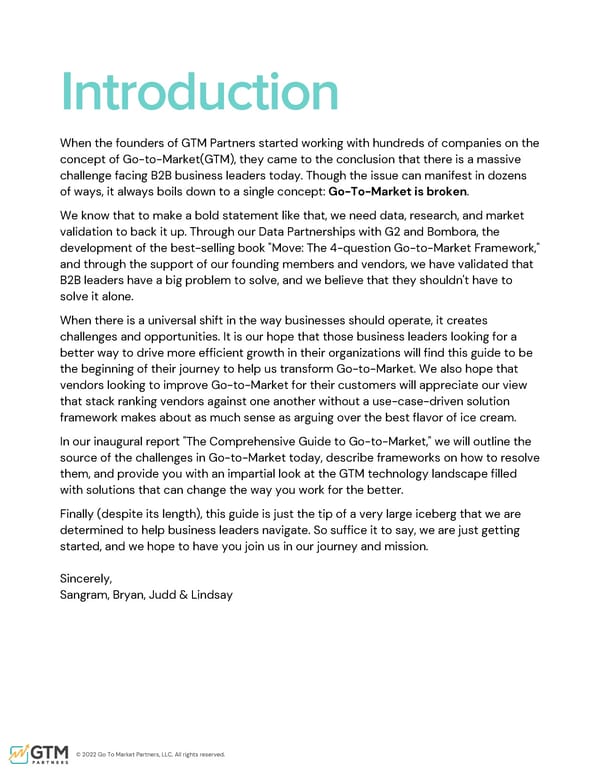
This is a modal window.
Our Sponsors Thank you to our GTM Sponsors, Partners and our network of professionals who put their faith in us to bring the GTM revolution to life for their teams and customers – we are humbled and honored by your support. © 2022 Go To Market Partners, LLC. All rights reserved.
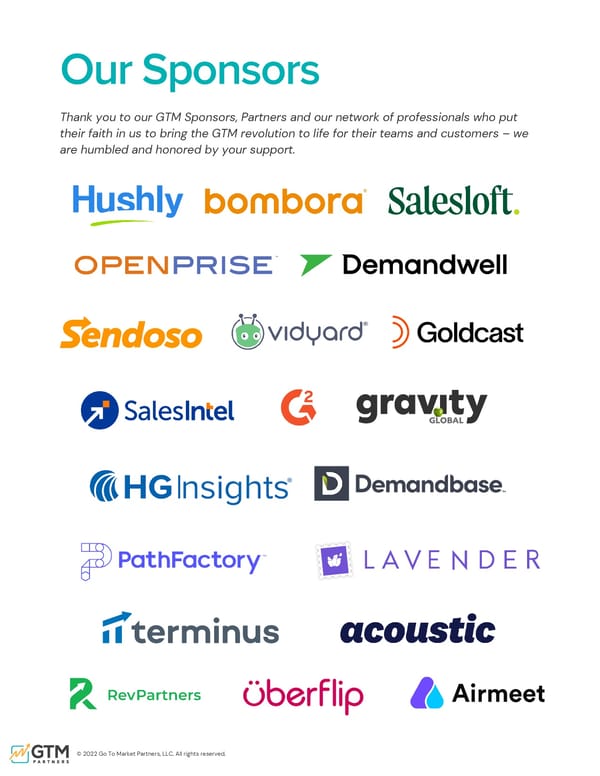
The Source of GTM Complexity The last 20 years have seen monumental In an effort to provide these better changes in how buyers buy and how B2B experiences with more unique and companies market, sell, and deliver value. customized outcomes, we have created Suffice it to say, we could summarize all specialized roles in customer-facing that into the digitization of everything – departments to make sure we can deliver learning, buying, marketing, selling, to our growing buying committees and servicing, events, remote work, and more complex buyers. communication. This environment of instant information, lower-cost There was a time when we could simplify customization, and personalized our Go-to-Market teams into Sales and experiences has increased expectations. Marketing. However, as the sophistication Both buyers and the employees of B2B and needs of buyers have evolved and companies have taken center stage, businesses have invested in larger teams forcing a positive change in the way with more specialized roles and companies must create value in order to resources, the concept of planning and grow. To put it bluntly, if a buyer doesn’t executing a Go-to-Market strategy also like the way you interact with them, they has to evolve. For example, the idea that will go somewhere else, and if the you can simply measure the success of employee can’t connect the dots from your marketing organization via the the work they do to positive company pipeline they generate is fine for a top- and customer outcomes, they will also go line goal. However, when the skills and somewhere else. expectations of a highly specialized demand generation marketer are very different from the skills and expectations of a brand marketer, trying to pinpoint an issue can be a challenge. Should we fail to meet our pipeline expectations in a quarter, we often ask ourselves, "Do we 8 have a brand or positioning problem, or Typical number of are we just not reaching the right people at the right time?" The specialization that handoffs during the has allowed us to drive better customer acquisition experiences for our customers has also & delivery process made it more difficult to predict and diagnose issues. © 2022 Go To Market Partners, LLC. All rights reserved.
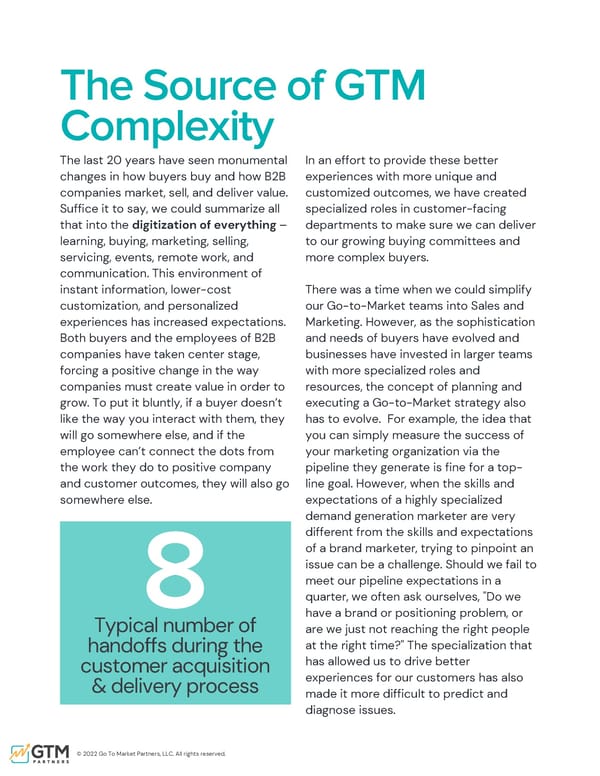
In addition to the complications within For example, if you start to see your departments, the number of departments expansion revenue decline, it could be that now have a significant stake in the because of a product issue, a messaging customer experience has also increased. and positioning issue, an issue with the Product, Marketing, Sales, Customer teams, audience you are attracting, an issue with and their supporting staff of RevOps and how you are selling, or an issue with how Enablement all have the ability to change a you are supporting the customer once they customer's perception of you. sign; even a combination of several of these challenges. People will renew or not renew a product because of product issues, because they The final layer of complexity exists in the felt they were sold something incorrectly, extensive number of tools and solutions because it was difficult for them to available in the Go-to-Market space to implement, or because the support staff "help" you pinpoint and resolve challenges. did not meet expectations. With so many products available, it can be overwhelming for a leader to decide which This further complicates the issue of tools they should invest their budget and pinpointing the reason behind a business time into integrating into their teams and challenge you may be experiencing. processes. In short, we know from our research that it is harder than ever before to manage, measure, and correct issues in your Go-to-Market. © 2022 Go To Market Partners, LLC. All rights reserved.
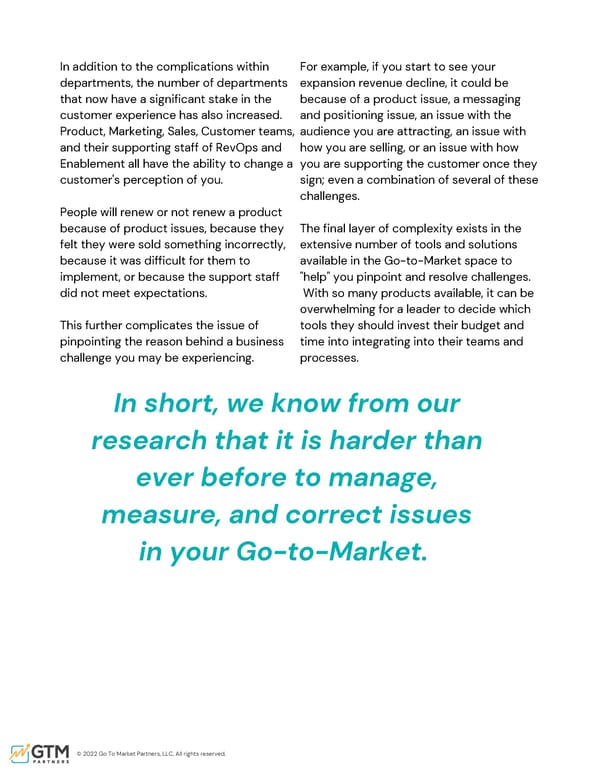
What Do You Mean By "Go-to-Market?" There is With every evolution, Go- confusion to-Market becomes more Most organizations believe that GTM is complex and owned by Marketing, Sales, or Marketing and Sales. But today’s growth plays misunderstood. Today we include Product-Led Growth, are in a quagmire of data, Community-Led, Channel/Partner-Led, ABM, Inbound, and Outbound. The revenue targets, teams, metrics we measure are no longer MQLs and an endless search for and SQLs, they are ARR, GRR, and NRR. This shift in growth plays and metrics growth at all costs. requires Marketing, Sales, and Customer It is our view that the framework for Success to be on the same page. GTM running a GTM process will be the has evolved and has become a holistic transformative driver of this next decade, and strategic initiative. But it lacks a just as the demand waterfall and flipped unifying definition and framework. funnel were for the last. In the late 90s, a sales professional would have thought that sales process, plays, automation, Marketing qualifying their leads, and "GTM having their calls recorded for later coaching would be heresy. belongs to So (not without resistance), we believe Marketing the unification of the GTM functions or Sales" (Marketing, Sales, Success, Service, RevOps, Enablement, and Product) under a GTM process (not an org chart) will allow B2B companies to execute more strategically, outmaneuver their 77% competitors, expand their markets, and drive customer lifetime value to new 1,000+ B2B Professionals heights. @GTM Partners © 2022 Go To Market Partners, LLC. All rights reserved.
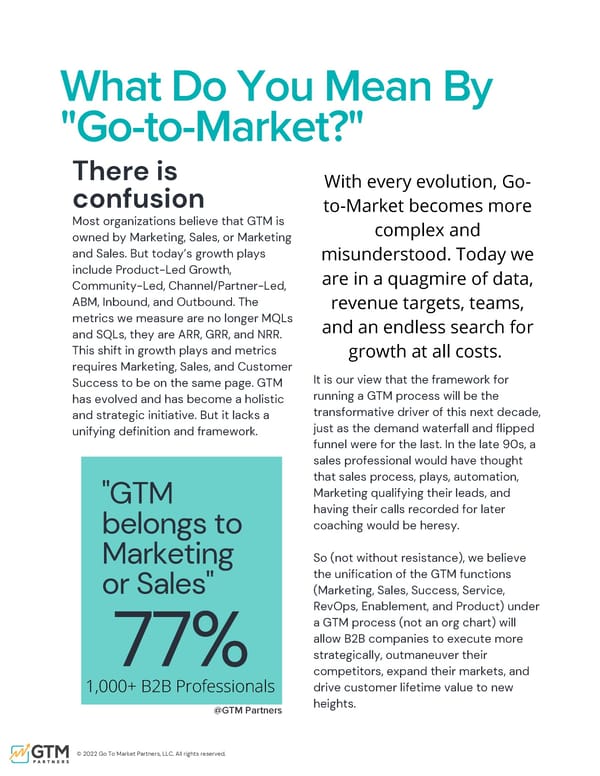
A New Definition for Go-to-Market Fundamentally, Go-to-Market (GTM) is the strategies and processes by which you bring a revenue-generating aspect of your business to the right buyers and continue to deliver on their expectations to ensure they remain your customers for as long as is appropriate. It is important to remember that GTM does not live in isolation, and in fact, is the operating system that connects and drives the three critical components of business transformation; namely strategy, planning, and execution. When strategy and planning are disconnected from your GTM, you will start to experience breakdowns between teams, either with disconnected processes, misaligned investments, or poor execution that could lead you to the conclusion that you made the wrong bets. Let's start with what Go-to-Market is not, which helps drive home the definition. Go-to-Market is NOT A one-and-done. It cannot be “cracked” at an executive offsite. A strategy or a project Just how you do sales or how you do marketing Go-to-Market IS An iterative and transformation process for your business Repeatable and scalable, and helps you answer billion-dollar questions like: when can we scale our business? A unifying force for your business @GTM Partners © 2022 Go To Market Partners, LLC. All rights reserved.
The 7 Types of Go-to-Market Most organizations have more Inbound-Led than one GTM type, and they absolutely have more than one Outbound-Led Go-to-Market Motion. Product-Led Channel-Led Go-to-Market "types" in this context refer to the many different ways you Event-Led can bring your products and services to the market. Each one of these Community-Led approaches requires its own strategy Ecosystem-Led and investment to ensure efficient growth. Depending on your approach, your growth levers are going to change, and therefore, how you pull on these levers will need to be refined. For example, spending significant resources on content and lead generation activities when you have a niche marketplace that demands an outbound motion is likely to increase your Cost of Acquisition (CAC) and not provide you with the results you desire. Even if your company is using only one type of GTM – “Inbound” for example – you most likely have multiple GTM Motions. A GTM Motion is a grouped set of products and segments that must be sold and serviced differently than another grouped set of products and segments. The most common example of this is when you see a company set up a different GTM Motion to serve an SMB or velocity segment vs. that of an enterprise segment. Why? Because the needs of the buyer and the requirements placed upon the GTM teams are so different that they can not be successful when assigned to the same resources. © 2022 Go To Market Partners, LLC. All rights reserved.
The 7 Types of Go-to-Market TYPE GROWTH LEVER EXECUTION Marketing harvests demand via Content Marketing driving Inbound-Led paid, organic, social, email, to to conversion channels qualify and route to Sales Marketing & Sales: Account- Coordinated and targeted Outbound-Led based marketing & selling, 1:1 account outreach advertising, content hubs, SDRs Product-driven adoption, Product facilitates deals, Product-Led usage & feature discovery upsells, usage, expansion Enablement focus to educate & Develop a network of Channel-Led support resellers, agencies, & distribution agents certified partners Targeted educational roadshow Premium event experiences Event-Led events, in-person, virtual, & to drive quality connections hybrid Thought Leadership driven by Create a movement or Community-Led industry experts, influencers, category around a and happy customers transformative idea App & data exchanges, co- Product integration & Ecosystem-Led marketing, integrated use cases symbiotic relationships @GTM Partners - gtmpartners.com © 2022 Go To Market Partners, LLC. All rights reserved.
When to Invest In Multiple GTM's 1 2 3 Adding a New Buyer Adding a New Adding a New Persona or Vertical Geography Product or Service Will you need to have Can the same sales, Is the product distinct new marketing, have marketing, onboarding, enough from your new types of sellers, and success resources current offering that adjust your onboarding, succeed selling and you give it a line item, and have success servicing the same you are adding new resources to satisfy the product(s) in a new competitors, or a expectations of the geography in the same different set of new Persona/Vertical? way? industry knowledge is required? The results "After" the 2012 decision speak for themselves and set The Optionality Tax HubSpot up for a decade of tremendous growth and expansion and the ability to run many GTM Motions. "It turns out the product requirements and support requirements, pricing, and everything were different for Ollie and Mary, and by not deciding, we made one uninspired compromise after another and never nailed either one. In 2012, we ripped the Band-Aid off and just picked Mary." - From then HubSpot CEO Brian Halligan This is a lesson in GTM Motions – by realizing that a single GTM Motion could not support two distinct segments, and without the resources to run two Motions simultaneously, they had to pick, choose, and declare what https://thinkgrowth.org/hubspot-s-playbook-for-going-from-startup- they would both do and not do. to-scale-up-29ab85d3a3e1 © 2022 Go To Market Partners, LLC. All rights reserved.
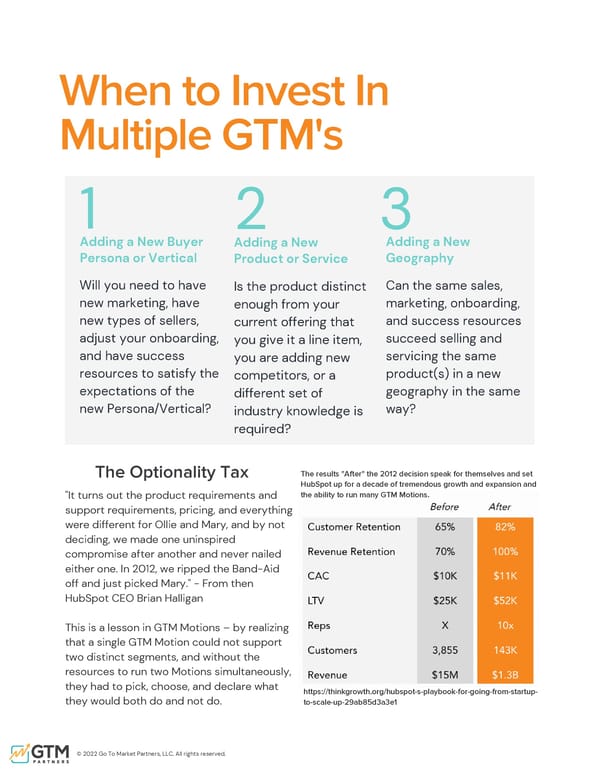
According to HubSpot, "We were acquiring Their well-intended but unfocused customers for approximately $10k, and we strategy, processes, and execution failed were getting a total lifetime value of to meet the needs of either buyer or approximately $25k. We bounced around in customer segment, which led to sluggish that range for years. When we hit the gas results. (hired faster), the math would get worse. When we slowed down, the math would get When they ultimately decided to focus better. We had an interesting business, but all of their resources on a specific without the ability to hit the gas pedal, we’d persona and designed a Go-to-Market never be able to truly scale and build the Motion (aligning Product, Marketing, company that we envisioned." Sales, and Customer Success) that spoke specifically to their Marketing The HubSpot team was split on exactly who buyer, they saw massive improvements their target market and ideal persona were. in customer retention, LTV, customer count, and revenue. Decision framework for determining whether or not you will need a new Go-to-Market Motion Add a new buyer? Can this be sold No No and delivered in the Hold or Can you fund and Add a new vertical? same way with execute a launch a new GTM Add a new product? existing resources limited test Motion? in Marketing, Sales Add a new geography? & CS? Yes Yes Add the initiative to an Launch the initiative existing GTM Motion using a new GTM Motion @GTM Partners In the end, it is critical to remember that Go-to-Market is rarely ever singular, and adding a new buyer persona, vertical, product line, or geography will typically require some level of investment. This could mean more money for resources, or it could mean strategically restructuring and reallocating your existing resources away from an existing revenue source in an effort to drive a new one. © 2022 Go To Market Partners, LLC. All rights reserved.
The Roles of Go-to-Market We advise that in lieu of looking for a With the expansion of the Go-to- single leader to drive the team, we should Market team, understanding the instead be creating clear and actionable different roles and how they will strategies and assigning roles and drive the business forward is responsibilities that will allow for the critical to your success. most efficient GTM team possible. The CEO should lead the way on the role It is common in most businesses to start assignment, looking for leaders who have small and slowly add more resources, the skills and tribal knowledge necessary increasing the size of your executive team, to be successful. building your strategic leadership team, and eventually even adding a third layer – Who Owns Go-to-Market a manager leadership team – which are all intended to communicate updates and CEO ensure there is alignment between CMO different groups in the organization. Often these meetings can become unwieldy as CRO you add new business segments and hire more experienced leaders to support an Other ever-growing group of individual contributors. 0 10 20 30 40 50 % Responses In an effort to reduce the chaos of these @GTM Partners Poll – 1000+ GTM Professionals meetings, we find that many executive leaders will assign "a single owner" to a function or task in an effort to hold that Avg. Tenure of GTM Execs one individual accountable and therefore reduce the complexity of having too many CEO voices in the room. Go-to-Market, with its inherent complexity, is commonly assigned CMO to a single group but is absolutely the responsibility of at least three to four teams. This creates a significant amount of CRO pressure on these roles and how they interact with other groups. 0 2 4 6 8 # Years @GTM Partners Wall Street Journal May 2022 © 2022 Go To Market Partners, LLC. All rights reserved.
The following chart outlines the makeup of an ideal GTM team. Depending on the size of your organization, you may have different titles or individuals wearing multiple hats, but making sure you have all areas represented is critical to your GTM success. Ideal Person: CEO, GM, or Division Head Mission: Align the executive team with incentives and KPIs across the business. Challenges: Final decision on which bets to take and which business you will walk away from. Keeping the team with varied skills a cohesive unit. Watching the long game. Secret Sauce: Make RevOps your key partner and maintain a neutral POV. Don't be afraid to combine departments to drive better cohesion if needed. Owner Ideal Person: CMO, VP of Marketing + CPO Mission: Ensure there are resources assigned to create a consistent Go-to- Market process from brand experience through to customer renewal. Challenges: Have a strong strategy and be strong in its execution. This role is subject to "big ideas" from non-practitioners that can throw your plan off course. Secret Sauce: Do not rely on funnels to drive growth, stay connected with the Galvanizer CPO, CRO, and finance to expand channels as appropriate. Ideal Person: CRO, CSO, VP of Sales Mission: Deliver the experience to future and current customers. Challenges: Enabling your staff to execute flawlessly and maintain a pipeline of individual contributors that will be able to help you scale. Secret Sauce: Have multiple avenues for making the revenue goal to manage the risk of unpredictable distribution channel behavior. Make your Marquee brands wildly successful and promote them extensively. Orchestrator Ideal Person: Director of RevOps, RevOps Manager Mission: Single source of GTM performance data in the organization. Be curious, ask questions, and tease out challenges before they become problems. Challenges: Data management and translation, avoiding data rabbit holes, avoid massaging data to tell stories because it is what people want to hear. Secret Sauce: Have your finger on the pulse of the organization. Build solid relationships with all GTM leaders. Be prepared to be their "revenue therapist." Truth Sourcer Ideal Person: CSO, VP of CS, Head of CS Mission: Maintain a customer experience that will pay dividends in the future. Challenges: Finding the right blend of connected experiences and keeping your costs as efficient as possible. Secret Sauce: Become best friends with your Sales counterparts, help them sell and ensure they understand the value of the relationship. Set up a customer advisory board to have non-biased customer opinion data at the ready. Unifier Ideal Person: Head of Enablement, VP of Enablement Mission: Understand each role in the GTM team and educate on strategy changes. Be the source of knowledge for your GTM executives and ICs. Challenges: Find the balance of maintaining the speed while not overwhelming your teams with change. Secret Sauce: Keep your finger on the pulse of ICs. Create strong onboarding programs to gain trust early and understand information uptake speeds. Enabler @GTM Partners © 2022 Go To Market Partners, LLC. All rights reserved.
Is Your Go-to-Market Broken? In this situation, broken rarely means there is a complete breakdown in your Go-to- Market approach, but in most companies, GTM is broken to some degree. The difficulty is that most leaders know something is wrong but can’t quite ascertain the exact problem. These issues manifest in convoluted ways, and conversations with department heads seem to make sense, but initiatives that are put in place don't seem to move the needle. The following questions can help you understand if you have some risks in your Go- to-Market and how we would advise further teasing out your opportunities to improve. 15 REASONS - WHY YOUR GTM IS BROKEN Business is relying on heroic sales players and not plays Yes / No Sales, Marketing, and Customer Success are out of sync Yes / No You can’t predict and forecast revenue for the next two quarters Yes / No Yes / No Heavy discounting and feature wars are eroding your value prop Your customers love you, but can’t quantify their ROI at renewal time Yes / No You can’t prioritize or say no to new initiatives Yes / No Yes / No Your team is not aligned on an executive strategy Your churn is killing your business Yes / No Your competitors are winning more market share Yes / No You are THE last to enter a deal cycle Yes / No Yes / No Your team is reactive, not proactive Yes / No You want to go up-market but the customer base is SMB Your analyst relations are weak, at best, to drive material influence Yes / No Yes / No Your point of view is not differentiated with your product You are struggling to go from a product to a platform company Yes / No @GTM Partners If you answered yes to more than a handful of these questions, you have some potential growth risk related to your Go-to-Market that could have long-term negative impacts on your business. © 2022 Go To Market Partners, LLC. All rights reserved.
The 5 Valleys of Revenue Death If your company has a subpar GTM process, then you inevitably end up slicing the revenue pie further with each new attempt at revenue expansion (new markets or products), rather than growing the pie. CREATE BUT CAN'T MARKET When Marketing, Sales, and Success are disconnected, inserting You have launched more products and solutions will inflate expenses disproportionally a product but can’t to revenue. create enough demand for it. This is why GTM should be an ongoing strategic objective and not a 1 project or moment in time after a launch or acquisition. Part of the strategy is knowing that the path isn’t going to be linear. It's going to MARKET BUT be filled with peaks and valleys. Investing in your GTM capabilities CAN'T SELL gives you the ability to capitalize on the peaks and navigate the You are generating valleys. enough demand but can’t seem to @GTM Partners close enough sales. 2 SELL BUT CAN'T DELIVER You close customers but your customer team struggles to deliver or has to reset expectations. 3 DELIVER BUT CAN'T RENEW Your customers love your product but can’t seem to quantify the ROI enough to renew. 4 RENEW BUT One tricky aspect of the Valley of Death is that you can be CAN'T EXPAND experiencing revenue growth and still be suffering the Your customers like consequences of a failing GTM. When your teams are out of sync, what you do, but fail other teams can overcompensate and keep moving the ball to see your value forward, but inefficiently. For example, a strong marketing pipeline increase as your 5 solution improves. can cover for low sales conversion rates, and Sales can often sell ahead of product capabilities, but these are short-term fixes that @GTM Partners create a shaky foundation that you may not be able to grind your way out of. © 2022 Go To Market Partners, LLC. All rights reserved.
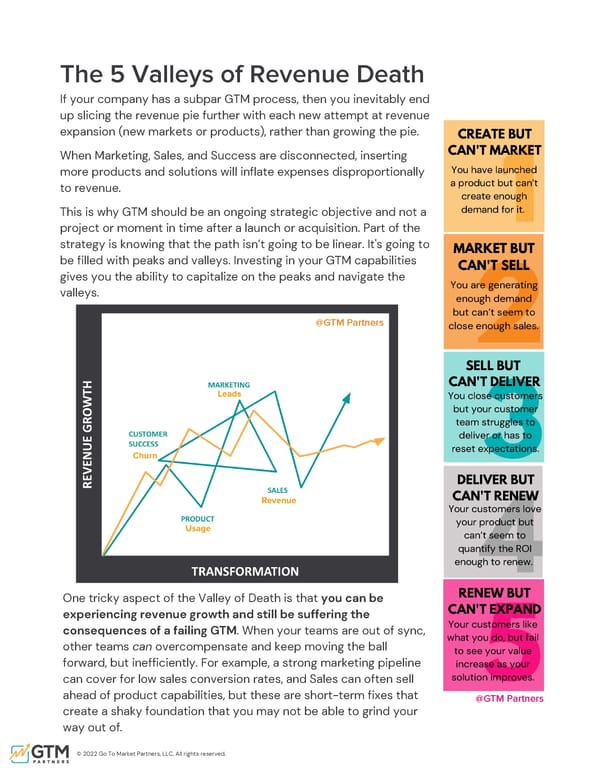
The whole point of the Valleys of Death is Valleys of Death & knowing they exist and identifying them early enough so that you can navigate Mature Organizations them better. This is where GTM is your When you think about the Valleys of Death, secret weapon. Having the right GTM they can feel very much like issues more process in place will ensure that you related to a company getting started. For don’t plateau and fall into a Valley of example many mature organizations have Death. been thinking about NRR and GRR for When you hit these Valleys of Death, we decades – surely you have escaped the tend to fall back into old habits and start Valley? Unfortunately, larger companies will to oversimplify our Go-to-Market still experience the Valleys because they problems by pointing fingers at will face new market conditions, new departments and individual leaders: competitors, changes in buying behavior, organizational restructuring, leadership We have a marketing problem. We changes, and the launch of a new product. have a sales problem. There are many mature companies that We need to fire the CMO, the CRO, or have a history of success in expansion the CCO. revenue that subsequently faced changes We need to hire more salespeople. that put that success at risk. The term We need to spend more on marketing “Valley of Death” sounds scary, but it activities. doesn’t have to be. By death, we mean a retraction in growth or a decline in growth But it's these biases that lead to the rate below your expectations, industry Valleys of Death. Most business leaders average, or competitors. When a we have spoken to have lost their jobs at competitor starts innovating better and least once because of a Valley of Death overtaking you, ask yourself – are we facing situation. But in reality, it's not their fault. a Valley of Death, and if so, what GTM The reason your company is facing a transformation is required to successfully Valley of Death is that your go-to-market navigate through it? is broken, and you have a go-to-market problem. © 2022 Go To Market Partners, LLC. All rights reserved.
Strategic Planning Has Failed You Does this sound familiar to you? A new revenue target has been set for the company. You have to 3X the existing revenue. So you do the math. Work yourself backward from the target – how many leads do you need? How many new salespeople will need to be hired? What’s the marketing budget to get there, etc.? Well, what if we told you this is the wrong approach? Hitting a revenue target is all about Go-to-Market, and you can’t math your way out of this. If you approach revenue like a math problem, chances are slim that you will hit your target; even if you do, you will be cutting a lot of corners to get there. "Mathing" your way to a revenue target is just one of the go-to-market biases that exist in the B2B tech industry. There are several more. GTM BIASES – THE 5 "ISMS" Mathism Spreadsheet over strategy Incrementalism Risk aversion over decision-making Departmentalism Team outcomes prioritized over customer experience Growthism Short-term wins at the cost of long-term planning Sizism Future possibility over near-term reality @GTM Partners These biases stem from the poor way in which companies approach annual strategic planning, targets, and goals. By focusing their efforts on the issues within departments, they miss the real issue – annual planning should start with strategy conversations and the trade-offs that must occur at a company level long before you ever discuss what will happen in each department. Remember, the goal of GTM is to acquire, keep, and grow customer relationships – this kind of thinking can not be done in a spreadsheet, like the ones that produce the growth percentage target that is typically handed down to departmental leaders from finance. © 2022 Go To Market Partners, LLC. All rights reserved.
Solutions to Go-to-Market Problems The complexity of modern GTM requires a new model for how companies should run annual/quarterly strategic planning, goal setting, budgeting, and execution of the plan. Namely, we must embed the Go-to-Market process into the strategy and planning process, using it to both inform and be informed by it. Frameworks to Fix GTM 1 3 2 M.O.V.E. GTM Operating The C.A.T. Framework System Framework The M.O.V.E. framework C.A.T. stands for Clarity, The GTM Operating uses the paradigms of Alignment, Team & System provides Market, Operations, Technology and is the blueprints for how to Velocity, and Expansion framework for leaders to tactically manage the to operationalize the keep their teams moving execution of a successful decision-making in the in the same direction. GTM Motion. strategic planning. Transformational Growth Business Model @GTM Partners © 2022 Go To Market Partners, LLC. All rights reserved.
The M.O.V.E. Framework Strategy and planning processes have multiple frameworks that already exist. But GTM is about creating a transformation process and why we created the M.O.V.E. framework to help you transform and grow efficiently. The M.O.V.E. framework focuses on four key areas – market, operations, velocity, and expansion. As part of our mission to keep go-to-market simple, we distilled the framework into four key questions: Market: Whom should we market to? Operations: What do we need in order to operate effectively? Velocity: When can we scale our business? Expansion: Where can we grow the most? Regardless of the size of your business, which stage you are in, how much revenue you have made, or how many products you have launched, the questions will remain the same. Your answers will differ. And you keep revisiting these questions at every strategy and planning session. The four-question M.O.V.E. framework is designed to ensure that there is clarity and alignment among your executive team. Marketing, Sales, Customer Success, and product need to all be on the same page on the answers to these four questions. MOVE THE 4-QUESTION GTM FRAMEWORK Don’t focus on how big the market is. Focus on the market that WHO best matches the pain points that your product/service solves. Having a single source of truth in your data helps you make better WHAT business decisions. Have a plan to ramp up your staffing and your enablement efforts, so WHEN you can get ahead of volume, education, and change management within your organization. Have a plan for expansion that incorporates more than just your sales WHERE organization (e.g., partners & agencies, expand your coverage into new verticals or business types, or expand your product). @GTM Partners Your aim with your go-to-market framework should be to build a cohesive, trained, and responsive team that works together to understand, know, and serve the customer. © 2022 Go To Market Partners, LLC. All rights reserved.
The Go-to-Market Operating System We often hear business leaders speak to the desired outcomes as though they are the plan: “We need 3X pipeline,” “Increase NRR by 3 points,” “30% increase in revenue,” etc. However, without a systematic way of confirming you have the correct processes and investment to achieve the goal, you might struggle to see risks that could prevent you from reaching it. How do you bridge the gap between your strategic planning process and your execution? The GTM Operating System is an 8- pillar framework that we have developed to provide organizations with a blueprint to provide clarity and alignment in their strategic planning and execution process. How The GTM Operating System Works The GTM Operating System is made up of many interconnected parts that will allow your Go-to-Market team to stay aligned on a common goal, both as a GTM team and within specific disciplines such as Sales, Marketing, and Customer Success. It also allows the owner of GTM within your organization to validate your strategy and understand the capacity of the GTM team. The GTM Operating System provides blueprints for how to run a successful plan to manage the execution of a successful GTM Motion(s) across the entire company. Each pillar builds on the next, allowing you to connect the dots between teams with significantly different roles. These 8 pillars are critical to ensuring that GTM is a company-wide holistic initiative and not just a marketing and sales initiative. For example, without having the correct positioning and branding support, Sales will struggle to make their numbers, or if your customers can’t see value in your solution, having your revenue depend on expansion will become a challenge for your Account teams. © 2022 Go To Market Partners, LLC. All rights reserved.
8 Pillars of The Go-to-Market Operating System GTM PILLAR ITS PURPOSE CAPABILITIES Identify best-performing TAM, TRM, ICP, Scoring, Total Relevant segments, customer cohorts, Account & Contact Data Market future possibilities Identify your highest value Distinct GTMs, Revenue Modeling, Market products, sequencing, GTM types, Pricing & Packaging Investment Map motions POV & Brand Awareness, Brand strategy, point of view, Brand & Messaging & Positioning, GTM create and harvest demand, Demand Activation budgeting Building repeatable, scalable Sales Capacity Planning, Marketing Pipeline throughput and efficiencies to & Sales Plays, Sales Process Velocity meet targets Onboarding & Customer Success Create and manage a mutually Customer Plays, Adoption, Usage & beneficial relationship with your Time-to-Value Advocacy, Customer ROI customers Customer Cohorts, Account Strategies for driving expansion Customer Management Plays, Customer in your current customer base Expansion Lifetime Value The analytical information Single Source of Truth, Unified Revenue needed to power and hold your Data & Systems, Workflow & Operations teams accountable Automation Clarity. Alignment. Team. The care and coaching required Leadership & GTM Leadership Rhythm to motivate, educate, and enable Management GTM Leadership Dashboard(s) your people @GTM Partners © 2022 Go To Market Partners, LLC. All rights reserved.
By using this framework, you will be able to provide strategic and operational guidance to each of your GTM teams, help them communicate with one another, and ensure that strategy and execution handoffs are smooth and efficient as each phase in the GTM cycle continues. The Go-to-Market Operating System by GTM Partners TAM, TRM & ICP Clarity. Alignment. Team. Scoring, Account & Contact Data GTM Leadership Rhythm Segments & Cohorts GTM Leaders Dashboard(s) Highest Valued Products Single Source of Truth GTM Types & Motions Unified Data & Systems Revenue Modeling Workflow & Automation Pricing & Packaging POV & Brand Awareness Customer Cohort Management Messaging & Positioning Account Management Plays GTM Activation Customer Lifetime Value Sales Capacity Planning Onboarding & Customer Success Plays Marketing & Sales Plays Adoption, Usage & Advocacy Sales Process Customer ROI © 2022 Go To Market Partners, LLC. All rights reserved.
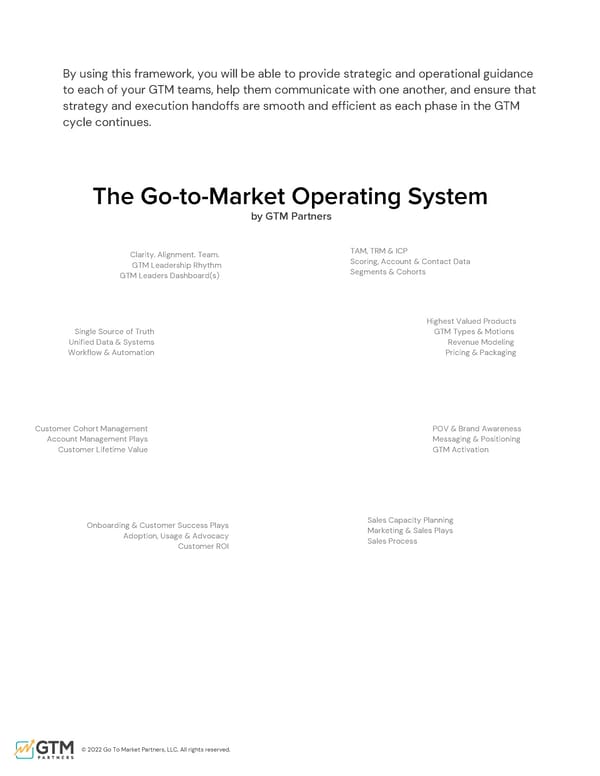
Clarity. Alignment. Team. (C.A.T.) The final framework in our Transformational Growth Business Model is all about the people, the hardworking GTM professionals we want to help work in a more effective way. In our experience, many of the issues related to Go-to-Market are due to misalignment challenges between leadership, teams, and individual functions. Teams are filled with busy people, and without these important alignment-setting actions, different groups can go months "doing" in silos, only to find out that they have failed to "accomplish" the actual goal. It is frustrating for them and risky for leadership and the business. C T A Clarity > Certainty Alignment > Right Team > Heroism This is the process of Scale, repeatability, and Where strategy is big ensuring that your team efficient growth are only picture, alignment is understands the possible with a team detail and in the trenches strategy, decisions, and mentality. With clarity decision-making, and corresponding goals for and alignment in place, agreements made in a the business, with a relying on "heroes" in the way that everyone can complete understanding organization in order to follow. of what those goals hit goals will not be mean within the context necessary and ensure Being aligned is better of their role. you mobilize all resources than being right, as it effectively to maximize allows you to execute, While you can rarely be output and efficiency. learn, iterate, and certain about what will ultimately transform as happen today, next Additionally, this will you go with everyone in week, or next year as a reduce the risk your lockstep. business, you can and organization has should must be clear about an A player team member The project list, what you are going to do decide to take another prioritization, and and not do, and about role and ensure the deliverables that result the order and timing you entire team can connect from this methodology will do it. Having a north their work to the goal and provide the relief and star allows teams and feel valued, which is an direction that your GTM individuals to make important aspect of team is craving. better decisions in their morale and mental health day-to-day to stay the at work. course for your strategy. @GTM Partners © 2022 Go To Market Partners, LLC. All rights reserved.
The Role of Technology in Go-to-Market Success Powered by If you have ever spoken to someone who For buyers of software, this section will markets or sells software for a living, then help you see in aggregate what the market you know that they spend most of their is choosing to spend their time and money waking hours trying to describe and show on as well as the types of problems or "use how their technology can solve problems cases" they are looking to have addressed. in your organization. This can be For software vendors, it is important to challenging because more often than not, understand that while you may be fighting technology alone cannot solve problems – for a specific budget line item, when we must first define our Go-to-Market and viewed holistically, you need to consider then determine the solution that will give how your categories are trending and us the most return on our investment. where other categories may be picking up In partnering with G2, we have reviewed steam, and what that might mean for your the most common trends in Go-to-Market growth expectations. technology buying over the past 5 years to observe what solutions people are looking for and where they are choosing to spend their budget. Over the last 4 years, we have seen a remarkable increase in awareness by B2B companies of the need to evolve the way they Go-to-Market. Digitization of the buying process, the need for efficient growth, and of course, the COVID pandemic, have accelerated the need for this Go-to- Market transformation. © 2022 Go To Market Partners, LLC. All rights reserved.

The Go-to-Market Cloud The GTM Cloud represents the software solutions that align with the 8 pillars of the GTM Operating System. In defining the characteristics of the cloud, we wanted to ensure that we never did a blanket "stack ranking" of the vendors. The right software solution for you has much more to do with your specific strategy and the use cases it must satisfy, rather than an arbitrary list of features you may never have a use for. Solutions are included in the GTM Cloud when they can support at least one of the following goals: 2 1 3 Provides Strategic Supports Multiple Supports GTM Data & Experiences GTM Departments Team Execution Vendors who provide The GTM pillars have Allows for a deeper solutions offering GTM natural departmental unification of your intelligence, planning, alignment (e.g. Brand & GTM process, and enablement of Demand = Marketing), improving your experiences that drive but many of those Clarity, Alignment, the actions for your solutions can support and Team while teams and customers. other teams (Sales). driving execution. As we have discussed, a strong Go-to-Market team relies first upon its leadership to build unity between teams, followed by the creation of a well-thought-out and tested strategy on how to achieve expectations, and finally, on the processes defined to ensure that the Go-to-Market Motions are fully developed. Once we have those elements in place, it is up to the teams to execute across Product, Marketing, Sales, and Customer Success. Steeped in the principles outlined in the GTM Operating System, the GTM Cloud highlights software that can make the strategy and planning work, the collaboration between teams happen, and the process that drives execution a reality. Using data from G2, we aligned the following categories (see table below) to G2's category definitions to observe recent trends for how B2B professionals research, adopt, and get value from their Go-to- Market technology investments. © 2022 Go To Market Partners, LLC. All rights reserved.
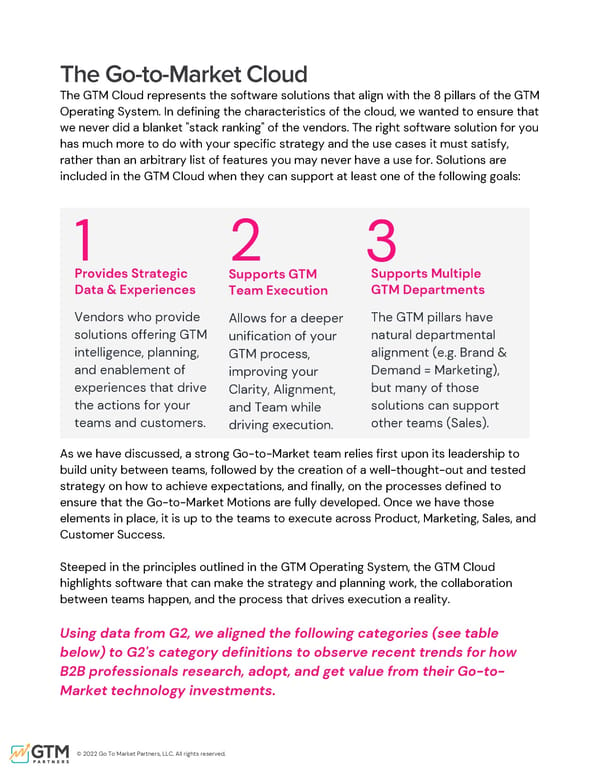
Solutions in The Go-to-Market Cloud GTM PILLAR RELEVANT CATEGORIES (EXAMPLES) Buyer Intent Data Tools, Account Data Management, Account Total Relevant Scoring, Engagement Data, Business & Sales Intelligence Market Product Management, Customer Journey Optimization Market Product Analytics Investment Map Digital Ads, Social, SEO, Marketing Automation, Lead Mgmt, Direct Brand & Mail, Event Management, Live & Managed Chat, Partner Demand Management, Account-Based Marketing, Content Exp Platforms Sales Engagement, Conversation Intelligence, Account Pipeline Intelligence, Sales Analytics, CPQ, Sales Process Experience, Velocity PRM, Demo Experience, Competitive Intelligence Customer Client Onboarding, Customer Success Training, Conversation Time-to-Value Intelligence, Production Adoption Platform, Customer Portal, Customer Advocacy, Learning Platforms, Social Customer & Customer Service, Customer Self-Service Expansion Revenue Operations & Intelligence, CRM, Lead-to-Account Revenue Matching and Routing, Analytics Platform, Data Cleansing and Operations Automation, Attribution Coaching, Employee Engagement, Learning Management Leadership & Platforms, Learning Experience Platforms, OKR, Performance Management Management, Employee Enablement @GTM Partners © 2022 Go To Market Partners, LLC. All rights reserved.
Categories in the Go-to-Market Cloud by GTM Partners Learning & Employee Enablement Development Employee Engagement Coaching Account Data Management Specialized Content Account Scoring Buyer Intent Data Tools Performance Management Business Intelligence Engagement Data Revenue Lead-to-Acct Operations & Matching Intelligence Product Management CRM Lead Assignment Product Analytics Routing Attribution Customer Journey Analytics Forecasting Optimization Platforms Board Management Voice of Customer Software Data Enrichment Data Cleansing Data Workflow & Automation Digital Ads Customer Advocacy Social SEO Client Onboarding Direct Mail Cloud Customer Portal Marketing Automation Customer Success Lead Management Training Event Management Conversation Intelligence Live & Managed Chat Production Adoption Platform Partner Management Account-Based Marketing Content Marketing CPQ Learning Platforms Account Data Customer Rev Management & Sales Engagement Optimization Intelligence RO&I Content Exp Customer Self- Sales Analytics Platforms Service Social Customer Conversation Lead Intelligence Conversational Service Intelligence Support © 2022 Go To Market Partners, LLC. All rights reserved.
The Search For Better B2B Go-to-Market Capabilities & Strategies The tremendous difficulties of the past few years drove "need to grow" through the roof, sending a massive wave of B2B professionals searching for better solutions. @GTM Partners Powered by G2 Data from over 19 million buyer intent signals The Secret Sauce of Marketing Marketing has tremendous Brand & Demand flexibility to ramp up and ramp down spend based on opportunity and risk. Unprecedented Investment in People – Pre-Recession Leadership & Management Under the backdrop of COVID and the great resignation, executives & boards doubled down on investments to better support, train, and empower their people. @GTM Partners Powered by G2 © 2022 Go To Market Partners, LLC. All rights reserved.
Key Takeaways for Go-to-Market Buying Trends These trends highlight a clear direction in Go-to-Market evolution and the importance of the 8 Pillar Go-to-Market Operating System. Demand for software focused on identifying the most ideal and in- 3.9x market customers is up 3.9x since 2018 Demand for software focused on driving growth through marketing 4.9x initiatives is up 4.9x since 2018 Demand for software focused on driving sales velocity is up 4.8x since 4.8x 2018 Demand for software focused on driving growth by improving existing 7.7x customer outcomes is up 7.7x since 2018 Demand for software focused on driving efficient growth through 3.6x RevOps is up 3.6x since 2018 Demand for software focused on helping leaders unify and strengthen 8.6x their GTM teams is up 8.6x since 2018 GTM TRANSFORMATION PRE POST LAST 4.5 PILLAR ACCELERATORS COVID COVID YEARS Total Relevant Avoid spending marketing dollars on non- 287% 61% 141% Market targets, better market & sales intelligence CMO, CPO, CRO Create & harvest demand differently, Brand & engaging buyers in new ways (digitally), Demand 393% 73% 185% MARKETING flexibility to throttle spend Need to better arm and systematize sales Pipeline teams while accelerating ramp to 383% 68% 187% Velocity productivity – sales tenure declines SALES Need for efficient growth driven by macro Customer TTV economic uncertainty has companies & Expansion 674% 111% 266% focused on NRR & GRR CUSTOMER SUCCESS Revenue Need for greater predictability, a single source of truth, data-driven decisions & Operations 49% 140% 257% OPS & FINANCE execution, unified data & systems Need to manage, support, train, incentivize, Leadership & & retain employees in a remote & health- 187% 200% 760% Management focused environment EXEC & ENABLEMENT @GTM Partners Powered by G2 © 2022 Go To Market Partners, LLC. All rights reserved.
B2B Professionals Searched G2 Over 7 Million Times Last Year for Solutions to Their Go-to-Market Challenges Note: If 20 people from one company searched G2 on the same day for the same solution it is counted as 1 search in this chart. @GTM Partners Powered by G2 Customer is Key to Driving Efficient Growth and NRR Solutions that drive customer time-to-value and customer expansion growing fastest, up 85% YoY, pointing to a shift in leadership posture towards the emphasis on Net Revenue Retention (NRR). @GTM Partners Powered by G2 © 2022 Go To Market Partners, LLC. All rights reserved.
Top 5 Most Researched Categories on G2 Across the GTM Pillars Sales Intelligence, Conversation Intelligence, Analytics Platforms, SEO, and Learning Platforms becoming foundational - CRM and Marketing Automation are ubiquitous. @GTM Partners Powered by G2 © 2022 Go To Market Partners, LLC. All rights reserved.
Top 5 Trending Categories on G2 Across the GTM Pillars Sales Coaching, Presales, Digital Sales Room, Social Media Marketing, and Promotional Product Management represent the fastest-growing YoY solutions and show us where Go-to-Market leaders are going next. @GTM Partners Powered by G2 © 2022 Go To Market Partners, LLC. All rights reserved.
Most Widely Adopted Go-to-Market Pillars Using the last 4.5 years of G2 Reviews as a proxy for what teams are adopting most, Marketing continues to lead the way with technology adoption while customer orgs use the fewest tools. With the increased focus on NRR, customer org leaders will need to expand their views that "selling" more value to the customer is not contrary to what's best for the customer. Q. How Does Your Go-to-Market Tech Stack Adoption Compare? 240,000 responses via reviews @GTM Partners Powered by G2 © 2022 Go To Market Partners, LLC. All rights reserved.

This is a modal window.
Top 20 Most Adopted Go-to-Market Solutions Since March 2020 (COVID) Another growing trend in the past 2 years is the increased investment in employee solutions, tools, data, and learning – how companies shifted focus to ensure their go-to-market teams were most successful during a period of massive transformation. @GTM Partners 105,000 responses via reviews Powered by G2 © 2022 Go To Market Partners, LLC. All rights reserved.
Most Adopted Go-to-Market Solutions Last 5 Years These are the solutions that have shaped the Go-To-Market transformation occurring over the last 5 years within the Computer Software industry specifically. @GTM Partners 62,000 responses via reviews Powered by G2 © 2022 Go To Market Partners, LLC. All rights reserved.

This is a modal window.
Product Usage Trends Implementation success is often linked to the customers willingness to expand the relationship specifically in competitive markets. Over half of the solutions reviewed are able to be deployed in less than 1 month. That said, a customers expected time- to-value for a given solution should be benchmarked against the category. Q. How Fast Can Your Go-to-Market Tech Be Deployed? 37,000 responses via reviews @GTM Partners Powered by G2 Looking at the pillars of the Operating System, the Total Relevant Market solutions, like intelligence data, can be quick to turn on and deploy and start to make an impact on a companies business. Leadership & Management solutions that help teams improve performance and productivity take more time to set up and roll out. @GTM Partners Powered by G2 © 2022 Go To Market Partners, LLC. All rights reserved.
Return on Investment is critical for renewal Nearly 50% of Go-to-Market solution investments can provide their return within 6 months. Q. How Fast Can Your Go-to-Market Tech Return ROI? 37,000 responses via reviews @GTM Partners Powered by G2 Investments in marketing have the fastest time to ROI, especially point solutions, whereas Leadership & Management investments that help teams improve performance and productivity take more time to see results. @GTM Partners Powered by G2 © 2022 Go To Market Partners, LLC. All rights reserved.
Closing Words This document aims to provide organizations and vendors with a comprehensive guide to Go-to-Market. GTM is not a one-off and neither is this guide. We will continue to evolve this guide in the months ahead. Our goal with this guide is to provide you with not just the WHY but also the HOW. This means diving deeper into the models, frameworks, data, and trends of GTM. We will also work with our vendors to create perspective briefs for their solutions. Our goal is to break away from the traditional stack ranking of vendors to a use case-based approach. This allows future customers of a GTM vendor to receive their expected return on investment, maximize product usage and have the right people managing the product. For our members, we will provide detailed guides, tools, and guidance you can use to make all of this information come to life in your organizations and for your teams. The next guide will be a deeper dive into our GTM Operating System. We look forward to being your impartial Go-To for Go-to-Market, as we continue to evangelize what true "Go-to-Market" means for B2B organizations. © 2022 Go To Market Partners, LLC. All rights reserved.
About GTM Partners About GTM Partners GTM Partners, a data-driven Go-To-Market Analyst firm helps organizations and GTM vendors to achieve efficient growth by transforming their GTM strategy. We work with high-growth companies to help them unify their GTM teams and to provide them with lasting strategies and frameworks. GTM Partners with a mission to make Go-To-Market simple aims to be the voice of the industry for all things GTM. We do this by offering: 1.Data and benchmarks collected from data providers, including G2 and Bombora, as well as our community of the world’s fastest-growing companies. 2.Research, best practices, and design frameworks to provide guidance on the best-in-class approaches to strategizing, executing, and tooling your Go-to-Market approach. 3.Personalized advice and support from experienced leaders and practitioners that help you address business challenges in a manner that is authentic and specific to you. Our consulting work focuses on areas such as Go-to-Market strategy, creating a Point of View, and Go-to-Market project execution strategy across the 8 pillars of GTM. 4.Events and networking with industry leaders looking to define the category of Go-to-Market and revolutionize the way we create value for our organizations. About the analysts Bryan Brown, Chief Analyst Bryan is a SaaS pioneer and thought leader in the marketing and sales tech industry. He has both created and brought to market innovative software products and ideas while helping thousands of companies in their effort to grow revenue more efficiently. Bryan is a co-founder with multiple exits (Vtrenz) has led strategy teams in Fortune 100 Companies (IBM) and has helped multiple organizations scale their products & Go-to-Market approaches from point solutions to platforms via organic product development and through mergers & acquisitions (Silverpop, Terminus). His work over the years has been instrumental in forming new categories and securing top placements for his companies in both the Forrester WAVE and Gartner Magic Quadrant reports. Lindsay Cordell, Senior Go-To-Market Analyst Lindsay is a practitioner turned analyst who studies best practices and trends in Go-to-Market and develops actionable models and blueprints for our clients. She has held both practitioner and leadership roles in almost every aspect of Go-to-Market, including Product, Marketing, Sales, Revenue Operations, and Enablement for several Fortune 500 companies, including AT&T, Hearst, and Cox. She most recently ran the GTM Center of Excellence for the Account-Based Marketing Platform Solution Terminus. Sangram Vajre, Co-founder and CEO Sangram is a three-time best-selling author and co-founder of several organizations, including Terminus, The Peak Community, and most recently, GTM Partners. Sangram has been at the forefront of B2B marketing trends, the Flip-my-Funnel movement, and defining the Account-Based Marketing category, ushering in a new generation of marketers. He has previously held CMO roles at Pardot, a Salesforce company, and Terminus. To find out how GTM Partners can help you with efficient growth and revenue, contact us at: Web: www.gtmpartners.com Email: [email protected] © 2022 Go To Market Partners, LLC. All rights reserved.


